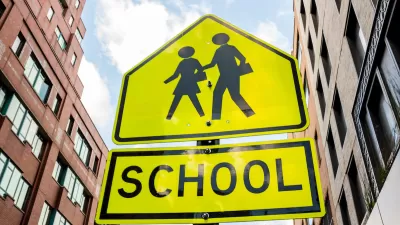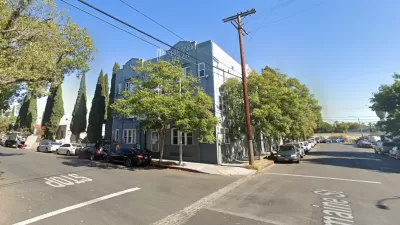Are pedestrian walk buttons effective, or do they only give us the illusion of control? It can vary.

With a focus on Washington D.C., Jordan Pascale discusses what can seem like one great mystery to pedestrians: the walk button. "You generally expect something to happen when you push a button. Especially when a sign encourages you do so. But that's not generally the case with pedestrian buttons in the District. They often don't accomplish what you're hoping for: the ability to cross the street faster."
Despite the distinct sense that walk buttons only give walkers the illusion of control, the situation has improved over time. Before the rise of computerized traffic signals, Pascale writes, pedestrians often had to resort to the "beg button" to get the right-of-way. Now, traffic signals generally give D.C. pedestrians the walk sign "when it's their turn." The downside is that "if there is a push button, it generally won’t make the walk signal come faster."
Still, on some intersections, pushing the button activates audio cues for the visually impaired. And D.C. has implemented HAWK (High-intensity Activated crossWalK) signals at some mid-block crossings for the sole benefit of pedestrians.
FULL STORY: You Pushed The Walk Button At An Intersection. So Why Don’t The Cars Stop?

Study: Maui’s Plan to Convert Vacation Rentals to Long-Term Housing Could Cause Nearly $1 Billion Economic Loss
The plan would reduce visitor accommodation by 25,% resulting in 1,900 jobs lost.

North Texas Transit Leaders Tout Benefits of TOD for Growing Region
At a summit focused on transit-oriented development, policymakers discussed how North Texas’ expanded light rail system can serve as a tool for economic growth.

Why Should We Subsidize Public Transportation?
Many public transit agencies face financial stress due to rising costs, declining fare revenue, and declining subsidies. Transit advocates must provide a strong business case for increasing public transit funding.

How to Make US Trains Faster
Changes to boarding platforms and a switch to electric trains could improve U.S. passenger rail service without the added cost of high-speed rail.

Columbia’s Revitalized ‘Loop’ Is a Hub for Local Entrepreneurs
A focus on small businesses is helping a commercial corridor in Columbia, Missouri thrive.

Invasive Insect Threatens Minnesota’s Ash Forests
The Emerald Ash Borer is a rapidly spreading invasive pest threatening Minnesota’s ash trees, and homeowners are encouraged to plant diverse replacement species, avoid moving ash firewood, and monitor for signs of infestation.
Urban Design for Planners 1: Software Tools
This six-course series explores essential urban design concepts using open source software and equips planners with the tools they need to participate fully in the urban design process.
Planning for Universal Design
Learn the tools for implementing Universal Design in planning regulations.
City of Santa Clarita
Ascent Environmental
Institute for Housing and Urban Development Studies (IHS)
City of Grandview
Harvard GSD Executive Education
Toledo-Lucas County Plan Commissions
Salt Lake City
NYU Wagner Graduate School of Public Service





























